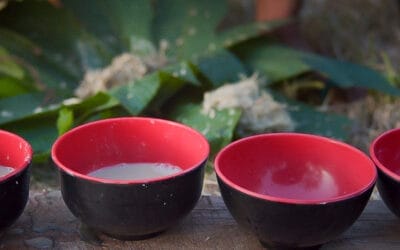Here in the US, kava root is gaining well-deserved popularity to calm the mind and body. Coming in the form of either: ground root, instant powder, or flavored drink products, its natural abilities for stress relief and relaxation at the end of the day are unparalleled. But in the South Pacific, kava has been used for centuries and more than just for relaxation.
The origins of kava
The regular consumption of Kava is thought to be fairly responsible for why people of the South Pacific are often referred to as the happiest and friendliest people in the world. Traditionally, it is used for all important ceremonies and social occasions. This can be from welcoming someone new into the village, celebrating weddings, and even being served at funerals. Kava is a large part of significant milestones in these traditional cultures. Additionally, kava is highly valued for its medicinal qualities as a sedative, muscle relaxant, diuretic, and a remedy for anxiety and insomnia. The social aspects though are what kava is most notorious for. Kava is well known to aid in open communication. Tom Harrison, in his book “Savage Civilization” (1937) said that “You feel friendly… never cross…. You cannot hate with Kava in you.” This is why kava is often used in village meetings for conflict resolution. Certain high-potency cultivars known as “War Kava” are drank as a last attempt for feuding tribes to come to an amicable agreement. Would be combatants sit down drinking kava together and discuss their issues, often coming to the conclusion that fighting is unnecessary.
There is some debate on the exact origin of kava but it is most often believed to have its start in Vanuatu where kava is often much stronger than varieties found in Fiji, Tonga, and Hawaii. There are also many more varieties grown in Vanuatu (over 80) compared to Fiji’s 12, Hawaii’s 13 varieties, 7 in Tonga, and a handful more throughout the other Pacific Islands.
The kava ceremony procedure
The ceremony typically follows the same format. A group of people will sit around in a circle with a large bowl (Tanoa/Kumete)
placed in the center. Kava is prepared within this circle. In Vanuatu, it is often prepared from fresh (green) kava and mashed with a mortar and pestle type set-up made from coral or chewed and spit into a bowl (Tanna). In Fiji dry kava is pounded by hand until it takes the form of powder and placed in a cloth sack.
The leader of the group strains the liquid through the cloth or woven leaves and into a cup (often a coconut shell). The leader — being the most important in ranking of the group — drinks from the cup and claps once. Then, the next important person in the group drinks and claps. This continues until every person in the circle has drunk kava. For more information on kava preparation, click here.
It is interesting to note, in Vanuatu an estimated 35% of people drink kava compared to less than 30% drinking alcohol.
Kava’s move to the US
What once was a celebratory and traditional relaxing drink for guests, family, and friends within the village is now growing into a popular relaxation drink in the US as well. Kava is used here more as a natural relief from everyday stress or even a substitute for alcohol.
With Kava Bars popping up in over 40 cities recently, more and more people are being introduced to the unique effects and benefits. Choosing to serve kava instead of alcohol, these bars offer a relaxing atmosphere open to all ages and unlike traditional bars that serve alcohol, there’s no worry of a fight breaking out or embarrassing behavior from overconsumption.
Apart from the kava bars, kava products are found in almost any health food store across the country and multiple online vendors. It is important to note though, the quality and effectiveness of products can vary widely. See our article about Tudei vs Noble Kava
The many kava roots available
The mind and body chill out after a glass of kava. It can be used to calm nerves after a stressful day at work. It can relieve muscle tension and soreness after a tough workout. It can even act as an aphrodisiac for men and women for added spice in the bedroom.
 Just like in the South Pacific, many different kava roots are available to purchase and brew yourself. Some of these roots include Tongan, Vanuatu, and Fiji kava root — named after their locations of origins.
Just like in the South Pacific, many different kava roots are available to purchase and brew yourself. Some of these roots include Tongan, Vanuatu, and Fiji kava root — named after their locations of origins.
Different roots can produce different tastes and effects (there are over 100 varieties) although kava brewed traditionally does have a very specific taste that’s described as earthy.
Luckily, if you’re not a fan of that flavor, pre-made kava drinks with fruity tastes and aromas are available to purchase. In the South Pacific the original kava root, unaltered by additional flavors, still takes precedence.
Takeaway:
Regardless of where you are, kava is a remarkable substitute to alcohol, a drink to relax and erase stress with non-addictive qualities that drinkers all over the world enjoy.
In the West, kava is seen as a natural herb to curb feelings of stress and alleviate moments of temporary anxiety. While in its place of origin, kava has traditional and spiritual connections when consumed. This includes the specific kava ritual typical within villages in the South Pacific.
Combining prescription medications or alcohol with kava not recommended. If concerned about drinking kava, consult your healthcare professional before you take the relaxing leap into making kava a part of your lifestyle.





